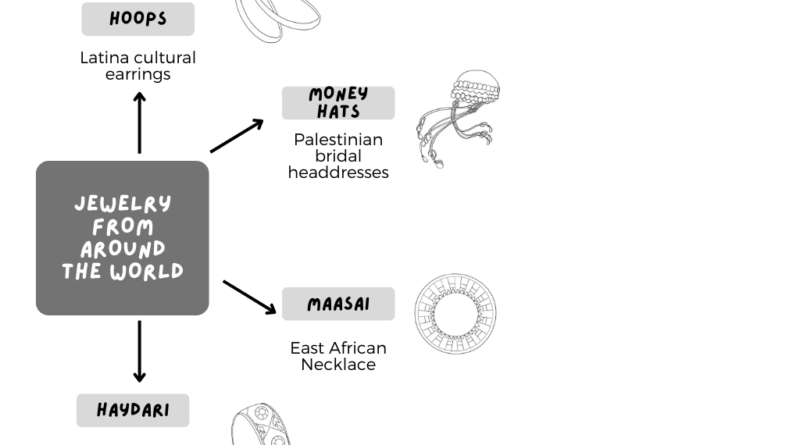Jewelry is a cornerstone of culture
By Luis Carvajal,
BlueDevilHUB Staff–
Jewelry serves a particular role in global feminine culture, helping promote individuality, maintain culture and identify influential components of a persons self.
“It is a really good representation of who you are as an individual, where you come from, and the groups you belong to,” Queer Student Union member Jules Retner said.
UC Davis professor of design Susan Avila teaches several courses oriented around fashion design and history on campus. She places emphasis on the importance of bodily decorations in relation to culture.
“Personal adornment is one of the fundamental aspects of identity and even in cultures where clothing isn’t worn we often see jewelry or body makeup/tattoos,” Avila said.
Yasmeen Al-Shinnawi is a prominent Palestinian leader on campus. She heads the Arab and South Asian Student Association, which like the various other culture clubs on campus, helps provide a sense of community for its members. Jewelry serves to advance this goal.
“With Palestinian jewelry, it has a very deep root in the culture. A long time ago, specifically in Bethlehem, a lot of people would wear a lot of different silver bracelets,” Al-Shinnawi said.
For close to 3,500 years, Bethlehem has served as a hub of trade for individuals traveling between Egypt, Syria and Palestine. As such, the region boasts a unique catalog of jewelry, especially bracelets.
The Haydari is a common bangle in Palestine which typically holds five gems intended to protect the wearer from the evil eye. As Palestinian olive trees can last up to 2000 years, oftentimes the bands are adorned with their branches, signifying the long lasting resistance of the Palestinian people.
“Tatreez are basically this type of embroidery that different women would use from different villages,” Al-Shinnawi said.
This regional embroidery serves to immediately distinguish an individual, and often adorns rings, bracelets, and other varieties of jewelry.
“Gold’s a really big part of our culture. For example if there’s a wedding, the groom’s family might buy a golden set for the bride’s family,” Al-Shinnawi said.
Headpieces are adorned with gold coins, and are external indicators of wealth amongst Palestinians, and of their culture globally.
Yusuf Abdelnur leads the Black Student Union and is the son of two Eritrean parents. In Eritrean culture, jewelry presents an outlet for cultural creativity.
“Culturally speaking, jewelry is definitely like a form of expression. (Africans) will wear jewelry at special events, at weddings, at celebrations, at religious events,” Abdelnur said.
Across African culture, there is a particular emphasis on the relationship between women and jewelry, who oftentimes adorn themselves with rings, bracelets, necklaces and head garments.
“I think black culture in general has that trendsetting drive. There’s a lot of things you see in (American) culture that have been popularized by (the Black community),” Abdelnur said.
Alongside this innovative mentality, Africa happens to be one of the most resource-rich regions of the planet. As a result, gold has remained a mainstay in its popular culture, even though the popularity of gold jewelry actually diminished during European colonization.
“We’re trying to take that back and be able to have a political undertone of being able to say we can get (our gold) back,” Abdelnur said.
Alondra Marquez serves as president of Latinos Unidos, and grew up immersed within her own Mexican culture.
Due to rigid gender roles within the Latino community, a heavy current of Hispanic feminism has surfaced in the last half century. Jewelry helps empower women.
“For (women) it’s a way of expressing ourselves I would say. A way of showing empowerment for women,” Marquez said.
Prevalent within Chicano culture, hoop earrings have become a staple of the rapidly expanding Mexican-American culture. Due to Latino America’s geography, certain resources and metals appear more frequently.
“We mostly always go for golden (jewelry), which is always the go to,” Marquez said.
Growing up, young Latina girls are adorned with bracelets and necklaces donning their names and national flags. In Latin American hospitals, some newborn girls often have their ears pierced immediately after birth.
“For certain people (jewelry) is more to top it off in your outfit, for Latin women, it’s just a part of us,” Marquez said.



